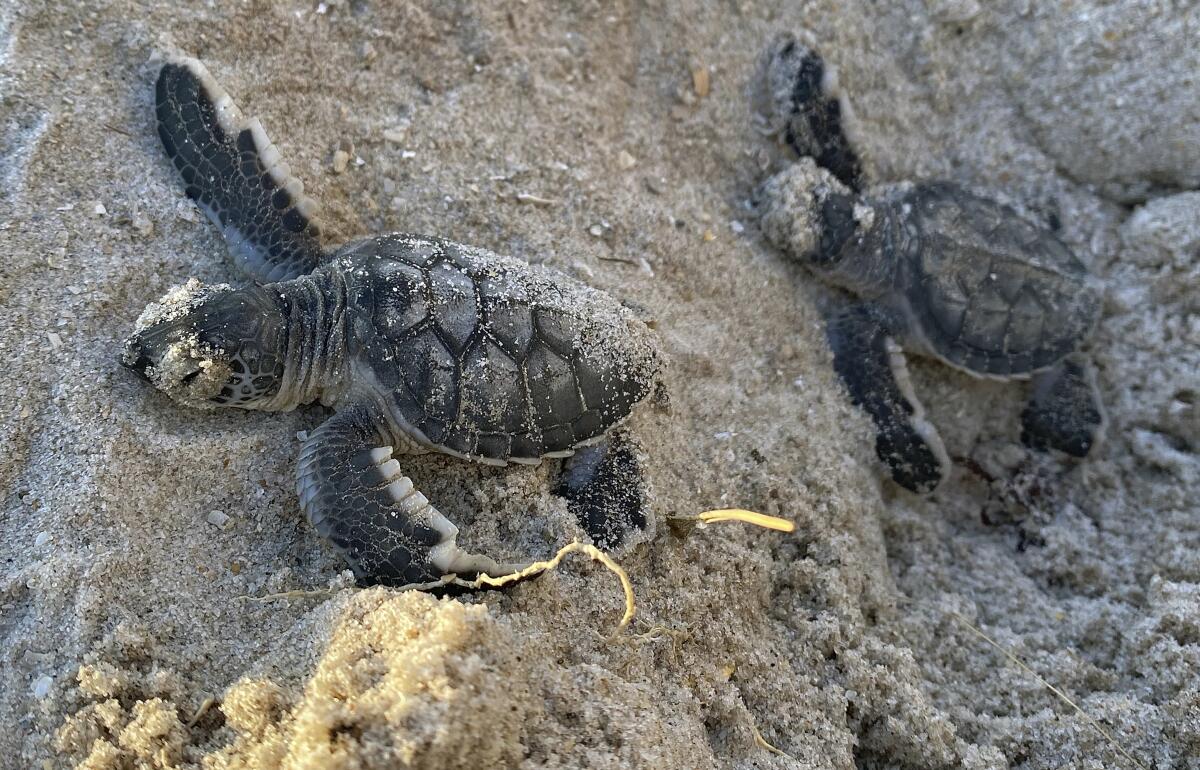Sea turtles break nesting records on U.S. beaches, but climate change threatens long-term survival

- Share via
INDIAN ROCKS BEACH, Fla. — Just as they have for millions of years, sea turtles by the thousands made their labored crawl from the ocean to U.S. beaches over the past several months to lay their eggs. This year, record nesting was found in Florida and elsewhere despite growing concern about threats from climate change.
Preliminary statistics in Florida show there were more than 133,840 loggerhead turtle nests, breaking a 2016 record. And for green turtles, estimates of at least 76,500 nests is well above the previous mark set in 2017.
High nest numbers also have been reported in South Carolina, Alabama, North Carolina and Georgia, although not all have set records like Florida’s.
“We had more nests than we had ever seen before on our local beaches,” said Justin Perrault, vice president of research at Loggerhead Marinelife Center in Juno Beach, Fla. “That’s quite a bit of nesting.”
His organization monitors Palm Beach County, which broke a local record by 4,000 nests.
Hamas releases 13 Israeli hostages and four foreigners in exchange for 39 Palestinians imprisoned by Israel after a delay of several hours.
There are seven species of sea turtles: loggerhead, green, leatherback, hawksbill, Kemp’s ridley, olive ridley and flatback. All are considered either endangered or threatened. They come ashore on summer nights, digging pits in the sand and depositing dozens of eggs before covering them up and returning to the sea.
Only about one in 1,000 sea turtle hatchlings live to adulthood. They face myriad natural threats, including predators on land and in the ocean, disruptions to nests and failure to make it to the water after hatching. This year, on a stretch of Florida’s Gulf Coast where 75 nests had been counted, most were wiped out by Hurricane Idalia’s surge in August.
“Unfortunately, the nests pre-Idalia were almost all lost due to the high tides and flooding on our barrier islands,” said Carly Oakley, senior turtle conservation biologist at Clearwater Marine Aquarium.
Female turtles generally lay eggs in a three-year cycle, leading to fluctuations in the number of nests from year to year, she said.
“The nesting process is very exhausting and, in this break, females regain the energy to do the process again,” Oakley said.
Climate change has added to those challenges, reducing beaches as sea levels rise and causing more powerful tropical storms. Hotter air, water and sand and changes in ocean currents turtles use to migrate also lower the odds of surviving, according to the conservation group Oceana.
Sand temperatures play a major role in determining sea turtle sex. In general, warmer temperatures produce more female turtles, and sand temperatures are projected to increase dramatically by 2100, according to researchers at Florida State University.
“So the warmer the nest is, the more likely that nest is to produce females,” Perrault said. “Additionally, hatchlings that come out of warmer nests are much smaller and often slower.”
A study led by FSU professor Mariana Fuentes and published in the Global Change Biology journal found sea turtles will have to nest much later or much earlier to cope with changing environmental conditions.
Even that may not be enough for every species, said Fuentes, who works in FSU’s Department of Earth, Ocean and Atmospheric Science. Turtles have adapted to altered climates over millions of years, but today’s changes may be too quickly for them, she said.
“We have found that even if they do change the timing of their nesting, that’s not going to be sufficient to maintain the temperatures of current nesting grounds,” Fuentes said.
Sea turtle mothers already have to lumber out of the water to find a good spot to nest, which can be difficult in areas where humans have built seawalls. Some female turtles make several attempts, known as false crawls, before finding a suitable location.
Racoons, coyotes and other predators often raid the nests, and hatchlings that dig their way out have to crawl to the sea before being snatched up by birds or other animals.
Electric lights can disorient them, causing turtles to head the wrong way on the beach instead of following light from the moon and stars. And when the lucky ones finally start swimming, hungry fish await.
Michelle Pate, biologist at the South Carolina Department of Natural Resources, said tens of thousands of hatchlings don’t make it to the water, even as nest numbers trend higher across the Southeast.
“If we can’t get hatchlings to emerge and make it to the ocean, then an increase in nest numbers doesn’t help,” she said.
The increase in turtle nests this year conceals an ominous future for the animals, Perrault said.
“Yes, we’re seeing record numbers, but our hatchling production may not be that great,” he said.
“And so in the future, 20 to 30 years from now, and these things come back to nest, we may not be seeing these record numbers that we’re seeing now.”
More to Read
Sign up for Essential California
The most important California stories and recommendations in your inbox every morning.
You may occasionally receive promotional content from the Los Angeles Times.











